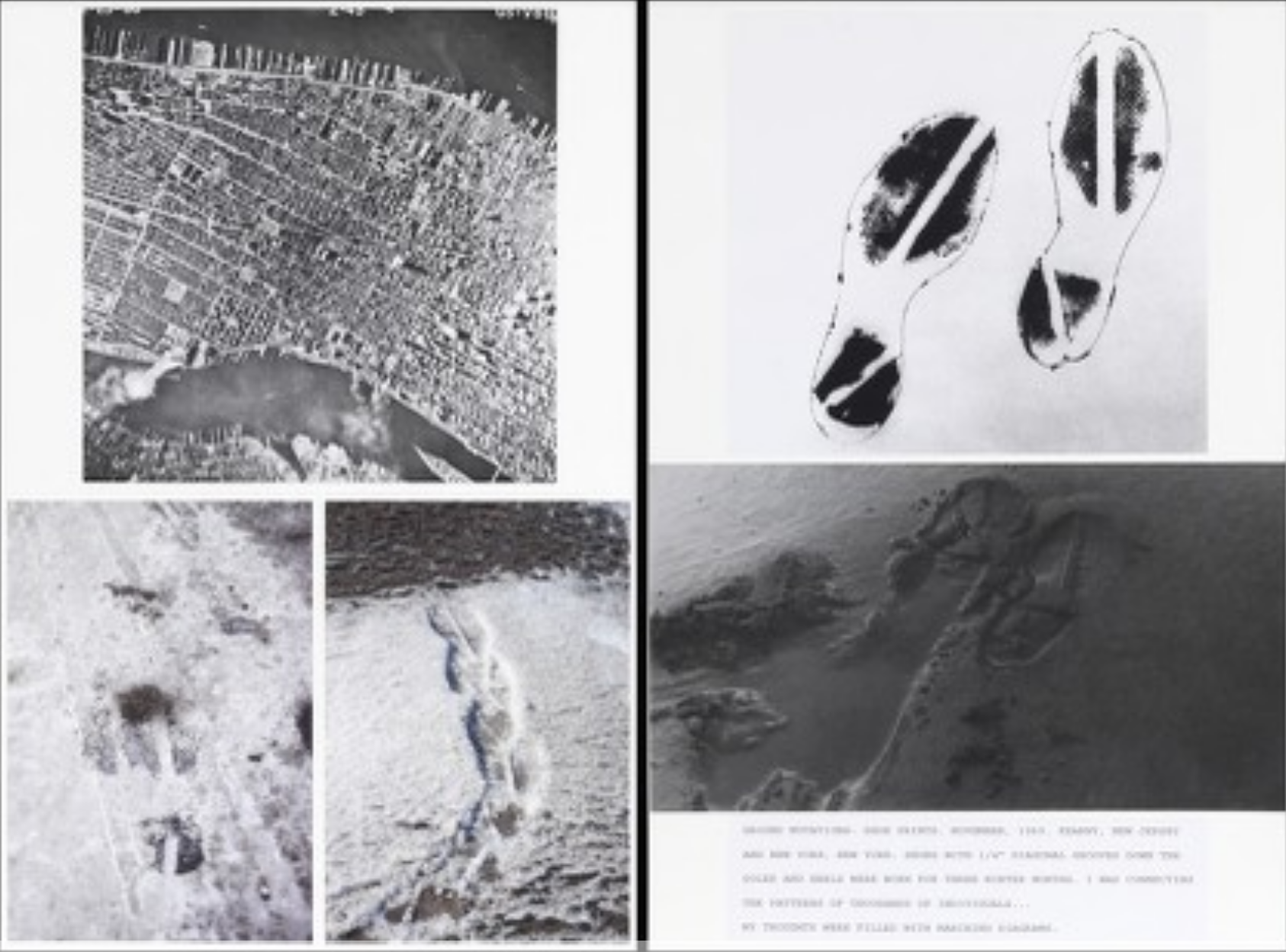
[credit]
Ground Mutations – Shoe Prints, November 1969, printed 2013
Black-and-white and color photographs and text on two panels
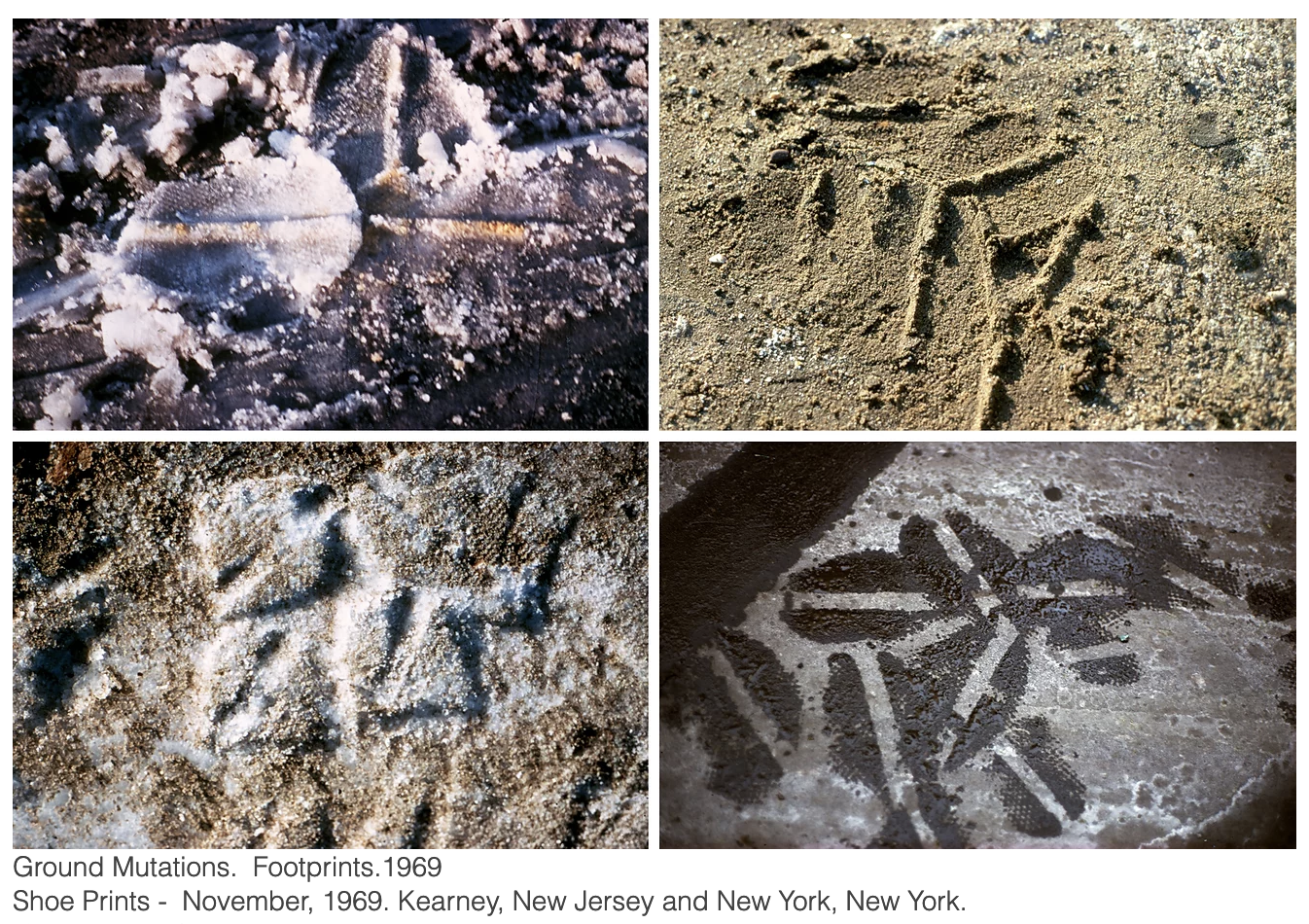
[credit]

[credit]
Black-and-white and color photographs and text on two panels

[credit]
“The Mirror Shield Project was initiated in support for the Water Protectors as Oceti Sakowin camp near Standing Rock, ND in 2016. Artist Cannupa Hanska Luger (Mandan, Hidatsa, Arikara, Lakota) created a tutorial video shared on social media inviting folks to create mirrored shields for use in onsite frontline actions. People from across the Nation created and sent these shields to the Water Protectors. The Mirror Shield Project has since been formatted and used in various resistance movements across the World.” [credit]
For the December 2016 iteration recorded using a drone camera, Luger collaborated with Rory Wakemup (Ojibwe) to orchestrate the more than 150 protesters. The work was inspired by Ukrainian revolutionaries who used mirrors to reflect back the images of Russian government forces. This iteration advanced nonviolent protest, referencing the reflected sky as well as the nearby river. (Morris, Kate. Shifting Grounds: Landscape in Contemporary Native American Art. University of Washington Press, 2019. Page 1.)
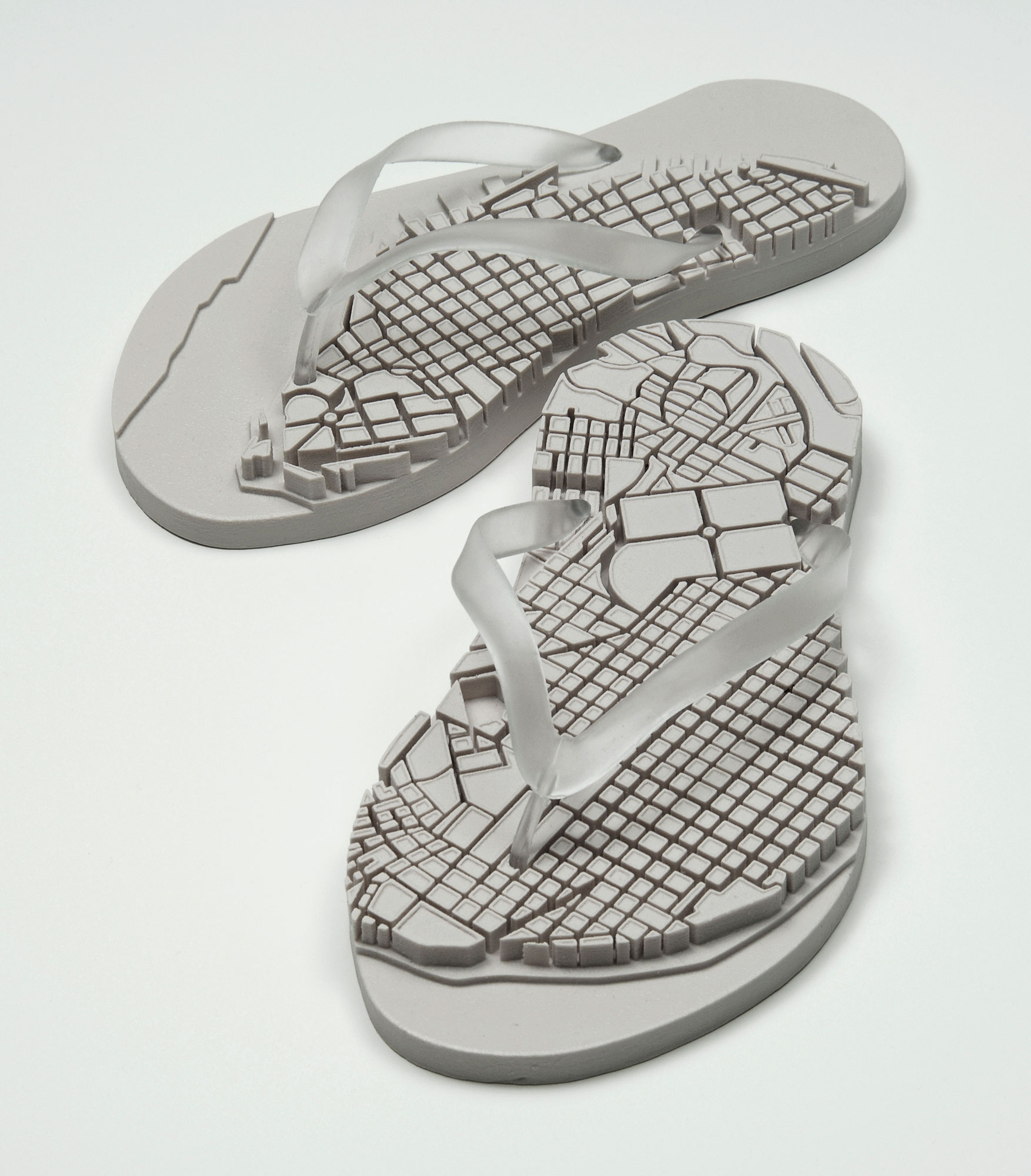
Two cast rubber sculptures
Each sandal: 12-3/4 x 5-3/4 x 2-1/2 inches
Edition: 60
“The sculpture multiple Sandalia is an edition of 60. The object is produced from a rapid prototype model and cast in rubber. By producing a limited edition of rubber sandals with relief maps of Havana neighborhoods on the soles, the artists adapted an ordinary object of mass production into a customized and poeticized icon that speaks of place, identity and culture. Sandalia derives from a series of watercolor drawings of sandals with maps. The right sandal depicts Old Havana, the left Vedado.”
“Over the past decade, Los Carpinteros (Marco Castillo and Dagoberto Rodriguez) have collaborated to develop their own poetic direction that functions in the imprecise boundary between art and craft traditions. Their carefully constructed works use humor to exploit a visual syntax that sets up contradictions among object, function and language.
Los Carpinteros have emerged as a vital force in the new, expanded terrain of global art. They live and work in Havana and Madrid and continue to travel and exhibit globally. For example: a major wall drawing was included in Drawing Now at the Museum of Modern Art-Queens, New York; their Transportable City was exhibited at the 7th Havana Biennial and at PS1 Contemporary Art Center in New York, the Los Angeles County Museum of Art, and the Contemporary Art Museum of Hawaii in Honolulu. In March, 2004 they exhibited a new body of work including drawings and large-scale wood sculptures at Anthony Grant, Inc. in New York City. In 2005 their exhibition Inventing the World premiered at the USF Contemporary Art Museum.”
[credit]
“Is there such a thing as portable green? What role can mobile nature play in the urban environment? The ‘Exhaust Garden’ offers a solution! Suppose you want to get away as a city dweller. You step into your portable garden, put on the shoulder straps and off you go: strolling through the busy city with your nose between the plants and grasses.”
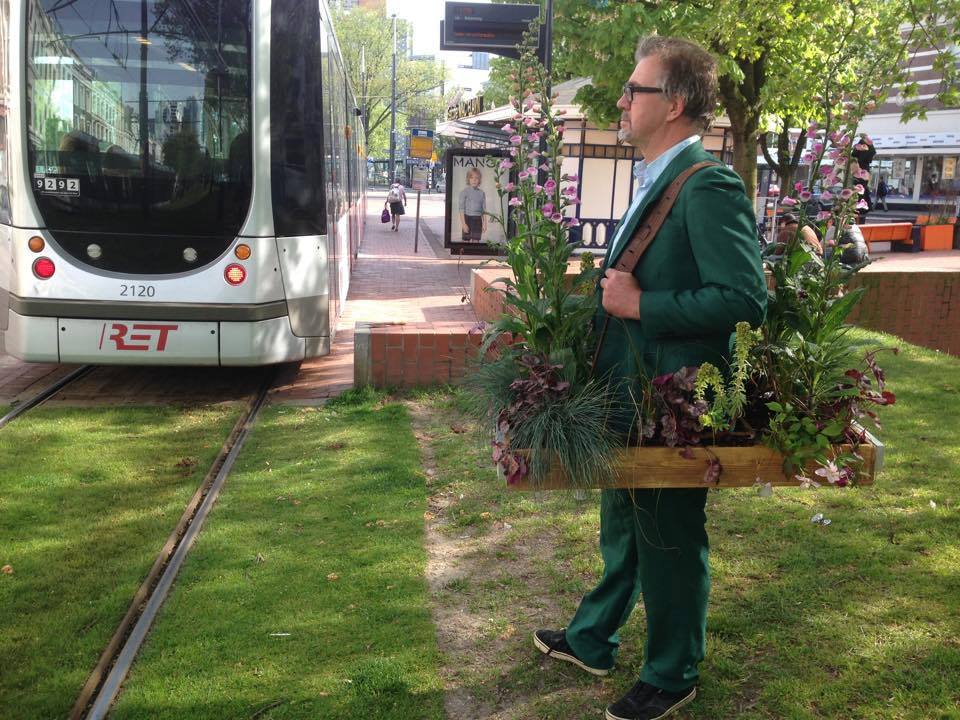
exhaust garden
“It all starts with a contribution to the ‘Hortus Conclusus’ exhibition in the Museum of Religious Art in Uden. In consultation with sculptor / landscape gardener Hans van Lunteren I make the ‘ENCLASS GARDEN’. The perspective within this portable garden has been reversed; it is nature that walls and shields man. The motif of the enclosed garden refers to the Garden of Eden or the Earthly Paradise where man lived in harmony with nature. The approach to paradise as something small and personal opens up interesting possibilities, of course.
Man destroys nature, man protects nature. The artists have played with this fact. They have reversed the perspective. With them, man is enclosed in a portable garden; the Homo Hortus Conclusus.
The square meter garden regularly goes outside, into nature, around the shoulders of people. The exuberant garden. Later versions of the ‘ENCLASS GARDEN’ have been developed specifically for the theme of an exhibition or respond to current events.”
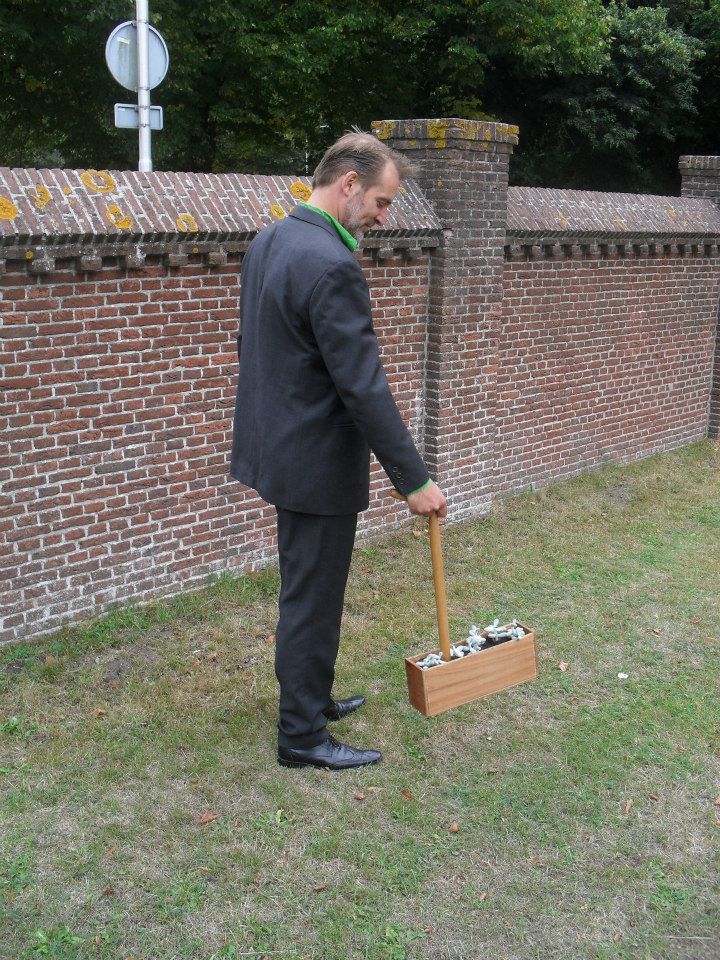
UITLAATTUIN-model-succulent
“When I notice a part of a hoe with the striking handle in addition to a wooden container intended for chalks and erasers among the waste at a primary school, a more manageable form of the ‘OUTLET GARDEN’ is born.
The ‘EXHAUST GARDEN’ has a wealth of possibilities. You can fill it with all kinds of herbs, vegetables or plants. You can of course make a statement by using your portable garden for endangered bees and butterflies. But you can also turn your garden into a mobile weather station, for example, by using guichelheil. Because the flowers of this plant close quickly when bad weather is on the way, guichelheil is also used as a (poor man) barometer.” [credit]
Reg Carremans (1981-) is a Brussels-based visual artist mapping the self and the environment through different media, to encourage critical introspection, (self-)awareness and reflective thought. Interested in humans as geographical beings (walking, landscape, environment, place, territory, cartography), and the artist and artistic processes (identity, basic actions, economy).
“Pathscape is a canvas walk for Sideways, a month-long itinerant initiative for contemporary art and culture. August – September 2012 | Belgium | Walks, canvas patchwork” [credit]
—
“Reg Carremans is a landscape painter who makes his work through walking or rubbing against the environment in which he is in. He was the only Belgian artist to complete the 375km Sideways 2012 Walking and Art Festival route, using canvas on the soles of specially adapted walking boots to gather multiple impressions for a series of ‘landscape paintings’ displayed en route.” [credit]
Unicorn appears in Horn’s 1970 film of the same name, and in her 1973 film Performances II.
“Unicorn is a white sculpture designed to be worn by a female performer. A series of vertical and horizontal white fabric straps serve as a kind of bodice that binds the performer’s naked body, with further straps connecting the neck to a tall, conical, horn-like structure that extends vertically from the top of the performer’s head. In an interview in 1993 Horn explained the development and original manifestation of this work, one of her earliest sculptures for the body:
[I had a vision] of this woman, another student. She was very tall and had a beautiful way of walking. I saw her in my mind’s eye, walking with this tall, white stick on her head which accentuated her graceful walk. I was very shy, but I started talking to her and proposed that I measure her to build this body-construction that she would have to wear naked and that would terminate in a large unicorn horn on her head. To my surprise she agreed … I invited some people and we went out to this forest at four AM. She walked all day through the fields … she was like an apparition.
(Quoted in Solomon R. Guggenheim Museum 1993, p.16.)
Developed from a 1968–9 preparatory sketch (Tate T12783), Unicorn is part of a series of body extensions – including Trunk 1967–9 (Tate T07855), Arm Extensions 1968 (Tate T07857), and Scratching Both Walls at Once 1974–5 (Tate T07846) – in which unwieldy prosthetics are used to emphasise the fragility and vulnerability of the human body. For Unicorn, however, the layers of meaning are more complex: the single woman clad in white, the original forest location and the symbolism of the unicorn reflect what curator Germano Celant has identified as Horn’s ‘intentional manifestation of white magic, in which woman tries to win out over reality and society’ (quoted in Solomon R. Guggenheim Museum 1993, p.44).
Emerging onto the art scene in the late 1960s, the German artist Rebecca Horn was part of a generation of artists whose work challenged the institutions, forces and structures that governed not only the art world but society at large. In art, this meant a renewed critical focus on the human body, contesting the commodification of art objects by foregrounding the individual. This focus on the human body took on a particular personal resonance for Horn, who was confined to hospitals and sanatoria for much of her early twenties after suffering from severe lung poisoning while working unprotected with polyester and fibreglass at Hamburg’s Academy of the Arts.
Horn has made work in a variety of media throughout her career, from drawing to installation, writing to filmmaking. Yet it is with her sculptural constructions for the body that she has undertaken the most systematic investigation of individual subjectivity. Her bodily extensions, for example, draw attention to the human need for interaction and control while also pointing to the futility of ambitions to overcome natural limitations. Similarly, her constructions, despite their medical imagery, are deliberately clumsy and functionless, while other works attest to the unacknowledged affinities between humans, animals and machines.
Further reading
Ida Gianelli (ed.), Rebecca Horn: Diving through Buster’s Bedroom, exhibition catalogue, Museum of Contemporary Art, Los Angeles 1990, pp.38–9.
Germano Celant, Nancy Spector, Giuliana Bruno and others, Rebecca Horn, exhibition catalogue, Solomon R. Guggenheim Museum, New York 1993, no.4.
Armin Zweite, Katharina Schmidt, Doris von Drathen and others, Rebecca Horn: Drawings, Sculptures, Installations, Films 1964–2006, Ostfildern 2006, pl.25.
Lucy Watling, August 2012″
[credit]
«Berlin Exercises in Nine Pieces» Exercise 1: Scratching Both Walls at Once, 1974 – 1975
Rebecca Horn (1944-) uses the «Finger Gloves» object to measure the dimensions of an interior space. The scratching of the body extensions is audible.
“Between 1968 and 1972, German artist Rebecca Horn created a series of performances titled “Personal Art.” Not unlike Joseph Beuys, an artist with whom she readily claims affinity, Horn ascribes the genesis of this work to a single near-death experience. As a young sculptor in the 1960s, Horn, like many artists of her generation, worked with fiberglass and polyester. Unaware of the toxicity of these materials, the artist suffered severe lung damage followed by a long period of convalescence. Limited to drawing in her hospital bed, Horn sketched images of the human body and designs for wearable sculptures, or “body extensions.” She then sewed and constructed these, tailoring them to exactly fit her measurements and those of her friends and collaborators. Made of cloth, wood, bandages, belts, feathers, and found objects, Horn’s masks and extensions contain, constrain, and/or elongate the bodies of their wearers. To this day, Horn can be said to continually build upon this oeuvre. She is known to return to earlier objects and performances by citing or even reworking them. “My works are stations in a transformative process,” she has said. A “development that is never really finished.”1
…
Conceived as dialogues between Horn’s body and the space, Berlin-Exercises revisits themes explored in “Performances II.” In Scratching Both Walls at Once the dimensions of Horn’s Finger Gloves are extended further. Keyed to the width of her studio, Horn slowly scratches the tips of these even longer gloves along the walls to either side.” [credit]
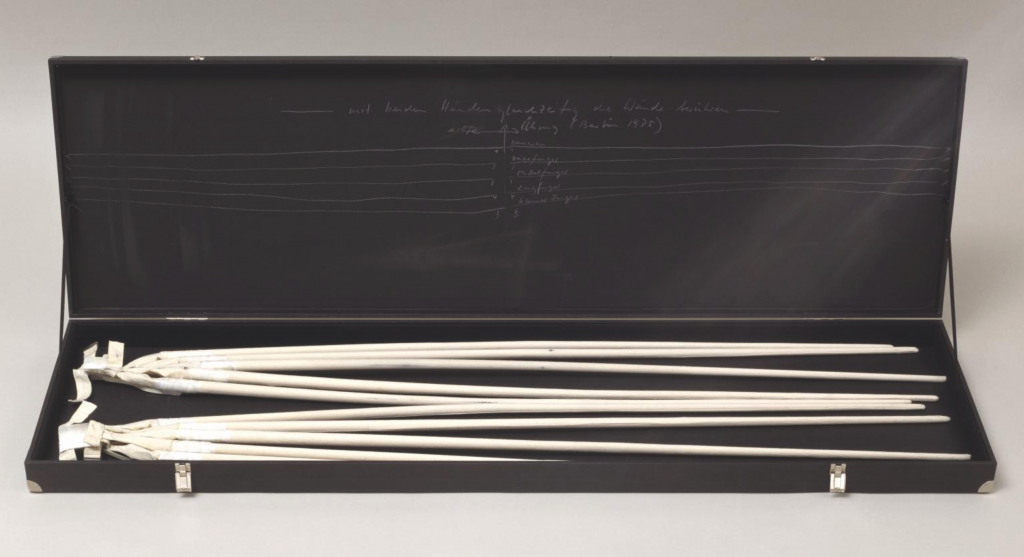
Fabric, wood and metal Object, each: 70 × 1735 × 45 mm; Credit
“Fissures, Holes, Limbs: breathing dislocated scales is an eco somatic sound walk centering disability.
I-Park Kicks off Seventh Art Biennale in East Haddam
BY CATE HEWITT, SEPTEMBER 23, 2019 ART & DESIGN
EAST HADDAM — At night, animals, birds, flowers, and even mushroom spores become active, moving about, making sounds and leaving traces, mostly unbeknownst to humans.
Participants in artist Moira Williams’ sound walk called “Fissures, Holes, Limbs: breathing dislocated scales,” were invited Sunday to shift from “daylight to moonlight” and experience night sounds and images she had recorded onsite at I-Park, an international artist-in-residence program founded in 2001.
Williams, a New-York-City-based artist, is one of nine artists in I-Park’s seventh Site-Responsive Art Biennale who spent three weeks on the program’s 450-acre campus “creating ephemeral artworks that respond to the property’s natural and built environments,” according to the program notes. The artists’ works can “take the form of environmental sculptures, videos, aural experiences or performance pieces.”
At the beginning of Williams’ sound walk, participants were asked to choose a stick from a number of precut tree branches, mostly about five or six feet in length. These branches were used as “limbs,” extensions of the human body, to explore holes and fissures in the path, as well as rocks and lichen.
After the band of sound walkers set off along a path, Williams stopped the group at a field and played a recording she had made while camping onsite of an owl hooting.
“Think of how the owl moves so quietly throughout the night and what it disturbs and what it accentuates, think of the different way our breath moves and accentuates as well, think of the spores and the seeds that we never see that we move,” she said.
She asked the group to face the field and to lift up their shoulders and think about them as wings, with the limb as an extension of sorts.
“Think about how they feel in the air and what you can move and what you can share and extend,” she said. “If you have a limb, an extra limb with you, please raise your limb in any way that you like, and think of your shoulders and your extra limb, think of the breeze going through your shoulders and your extra limb.”
Dressed in a white hazmat-type suit embellished with bright neon stripes made from tape, Williams carried a roll of black wire on one shoulder, like a techie epaulet, and a small speaker and projector connected to her mobile phone in a pouch around her waist. On her head was a wide “hat,” made from a piece of flat white painted cardboard with a space cut out for the top of her head, and long neon green streamers attached at each end that trailed behind her when she walked.
As the group proceeded down the path, Williams removed her hat and projected a tiny video of a fox she had recorded at night, letting the walkers experience the sight and sound as they hiked past.
She asked everyone with “an extra limb” to use it to touch the rocks, holes and lichen along the path, as a way to experience the site.
Soon the group came upon a field where Williams had created a labyrinth.
“Choose a path and walk to where you can find a white stump,” she instructed. “We’re under a full moon in the middle of the night, it’s an extraordinary full moon.”
Soon the group gathered around a white stump that had holes drilled in it about the size of the limb walking sticks. She asked those who had limbs to share them with those who were without.
“Those who haven’t had an extra limb, think of the limb that they now have and how the previous person used that limb and what that means to them not to have it now,” she said. “And think about whether the bark is smooth and whether there’s holes or fissures or lichen or even insects on your limb.”
Williams invited everyone holding a limb to place it in one of the holes in the stump, which created a kind of tree sculpture. The new tree symbolized connection, she said, and could forge a new identity for everyone who took part.
“If you walked with an extra limb and want to think about if you have a new name, you can say your new name out loud if you do have one, or if you can think of a new name that might incorporate an extended limb,” she told the group. “My new name would be Lichen.”
Of the 20 participants, names like Woody, Meadow, Shaggy, Hiawatha and Tripod emerged.
Then Williams directed the walkers’ attention to the far side of the meadow where a large tree with bare branches reached to the sky, a living reflection of the group’s tree made from limbs.
“Look at the tree in front of us and think about the tree behind us and the juncture of all of us connecting all of us,” she said.
Williams next led the group to a boardwalk that snaked through a marshy area with numerous streams flowing along the ground.
At one point she stepped out of the path and projected a video of mushrooms sporing onto a series of white vertical boards that were set in the marsh.
“This is an image of sporing mushrooms that only spore at night and these are things we seldom get to see,” she said. “They’re just ghostlike spores that we’re gathering on our own bodies and sharing with the rest of the world.”
Williams, who holds a BFA from the School of Visual Arts, a graduate certificate in “Spatial Politics,” and an MFA from Stony Brook University, said her underlying interest is about “making the environment accessible to all people, especially people with disabilities.
“It’s about thinking in ways that are not about independence but more about connectedness with the environment and one another,” she said. “It’s connectedness as a holistic ecosystem, we’re not just this very big myth about how we’re independent.”
She explained that her white outfit reflects a philosophy of healthcare — “the idea of nursing and empathy and being a caregiver.”
“I think of myself as a steward caregiver. I love wearing the white suit because I’m in the lead and I want people to see me,” she said. “The hat is a device to say, hey, here I am, come and join me, but it’s also the width of walkways that need to be for people that need a wheelchair.”
By walking through the marsh and the woods, participants will carry traces of the environment to new places, she said.
Near the end of the path, Williams crouched down, removed her hat and projected a time-lapse video of a lotus flower opening and closing at night on the pond at I-Park, a film she made while floating on the water.
The tour was over and she bade the group good-bye by saying, “Good morning everybody.””
ELEMENT from Michèle Magema on Vimeo.
“The artistic work of Michèle Magema is erected in an intermediate zone, a mental space, a produced border, an interstice located between the double Western and African projections.
The plurality of his affiliations allows him to question his history and that of a nation, a continent and more broadly of the World. The relationship she maintains with stories and History allows her to invent a critical posture.
Michèle stages herself, and reveals both her questioning and her discernment through her photos and video installations imbued with an intimate femininity, while addressing fundamental points in the history of humanity.
In Element, the artist tries to put into images universal exotic projections that are implied. A humming voice, sensual feet, shod in white accompanies a hand that picks cotton on the asphalt. A head, fragment, advances in profile, balancing a basin. The same chained ankle feet move slowly, in high heels. The three images coexist, carried by a long tracking shot that allows us to follow this woman, like the watermark of an evocation of the female condition in general.
Again, Michèle Magema tells and retells History in images. Drawing from the archives, restoring a balance in a rickety reality, she pursues her singular quest linked to her own cultural diversity as well as to her feminine gender.” [credit]
This work has multiple sections: déambulation, where the artist silently walks across the screen carrying two bags wearing a white dress; Expansion, where the artist walks up stairs and across the screen – the image is doubled and reflected with reduced opacity and there is piano music playing; Transcription, where the artist walks across the screen in a white dress with a piece of chalk drawing a hip-height line across a black wall, then erases the lines with water – again the image is doubled during the drawing, but not the erasing, and music is present for the erasure.
“My work exists within an intermediary zone, a sort of matter space of a frontier I have produced and that I situate within the countries of France and the Democratic Republic of Congo. I am a cultural hybrid endowed with a composite identity. The plurality of my parents provide me with the authorization to interrogate my own history and that of a nation, the place of my birth, as well as the continent of Africa at large. The relationship that I maintain with my own personal history or histories and to history as a larger entity permits me to formulate a critical acquisition to write the concept of exitism. Exitism is a representation that is largely shared with history and even with practices at times. As the material of my work is always simple. I use historical facts that I interpret through the prediction of scene. Through these frontal images I expose my body that I use as a metaphor for the relationship between the human being and the world at large. My work sets up a direct relationship that centered on the world the field of society and politics. – Excerpts from Global Feminisms: Michèle Magema 2010″ [credit]